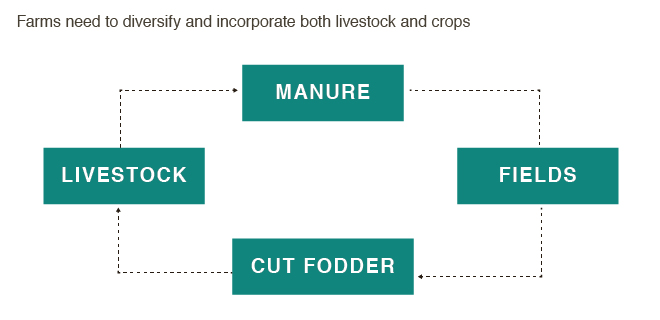Livestock

Facts
- Many options are available for adapting livestock production systems to a changed climate. These include: technological options (e.g. using species with greater drought tolerance); behavioural modifications (e.g. changes in dietary choices, such as consuming less meat); managerial choices (e.g. different farm management practices); and policy alternatives (e.g. planning regulations and infrastructural development). Some options may be appropriate for the short term, others for the long term and some for both (FAO 2013 p. 218).
- Adaptation options that have been tested among poorer households with livestock include: providing weather information to help them manage the risks associated with rainfall variability; implementing livestock insurance schemes that are weather-indexed, i.e., policy holders are paid in response to ‘trigger events’ such as abnormally high or low rainfall or high local animal mortality rates; and changing the mix of livestock species and/or breeds. For example, the Samburu of northern Kenya, who traditionally keep cattle, started keeping camels because of increasing drought, cattle raiding and diseases since the 1960s (Thornton and Gerber 2010 p. 175).
- Cross-breeding programmes can deliver simultaneous adaptation, food security and mitigation benefits. For example, composite cattle breeds developed in recent decades in northern Australia have greater heat tolerance, disease resistance, fitness and reproductive traits than pure shorthorn breeds that had previously dominated these harsh regions (FAO 2013 p. 221).
- Livestock can also act as a buffer in times of hardship and drought, because they can be sold to buy food (Toulmin 1986). Generally, livestock are more resistant to climate change than are crops because they are mobile and can travel to find feed (IFAD 2013).
- Possible barriers to adaptation within the livestock sector include: poor local infrastructure; lack of market access; lack of access to credit; poor access to water and water management technologies; poor or absent animal health services; and lacking access or knowledge of climate information (Porter et al. 2013).
Sources and further reading
- [FAO] Food and Agriculture Organization of the United Nations. 2013. Climate-smart agriculture sourcebook. Rome, Italy: Food and Agriculture Organization of the United Nations. (Available from http://www.fao.org/docrep/018/i3325e/i3325e.pdf) (Accessed 5 November 2013)
- [IFAD] International Fund for Agricultural Development. 2013. Livestock and climate change. Livestock Thematic Papers. Rome: IFAD (Available from http://www.ifad.org/lrkm/factsheet/cc.pdf) (Accessed on 5 November 2013)
- Porter JR, Xie L, Challinor A, Cochrane K, Howden M, Iqbal MM, Lobell D, Travasso MI. 2014. Food Security and Food Production Systems. In: Field CB, Barros VR, Dokken DJ, Mach KJ, Mastrandrea MD, Bilir TE, Chatterjee M, Ebi KL, Estrada YO, Genova RC, Girma B, Kissel ES, Levy AN, MacCracken S, Mastrandrea PR, White LL, eds. Climate Change 2014: Impacts, Adaptation, and Vulnerability. Part A: Global and Sectoral Aspects. Contribution of Working Group II to the Fifth Assessment Report of the Intergovernmental Panel on Climate Change. Cambridge and New York: Cambridge University Press. (Available from http://ipcc-wg2.gov/AR5/images/uploads/WGIIAR5-Chap7_FGDall.pdf)
- Thornton PK, Gerber P. 2010. Climate change and the growth of the livestock sector in developing countries. Mitigation and Adaptation Strategies for Global Change 15 (2):169–184. (Available from http://dx.doi.org/10.1007/s11027-009-9210-9)
- Toulmin C. 1986. Drought and the farming sector: Loss of farm animals and post-drought rehabilitation. ALPAN Network paper No. 10. Addis Ababa: International Livestock Centre for Africa. (Available from http://www.fao.org/wairdocs/ILRI/x5446E/x5446e00.htm) (Accessed on 5 November 2013)